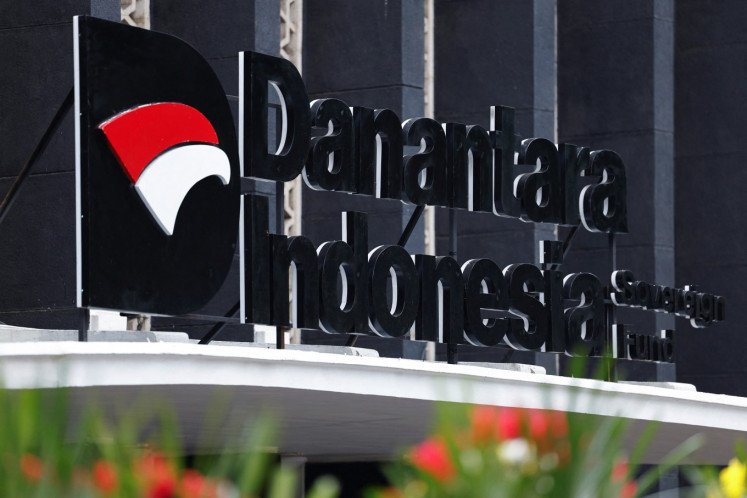Popular Reads
Top Results
Can't find what you're looking for?
View all search resultsPopular Reads
Top Results
Can't find what you're looking for?
View all search resultsDelicious Surprises for Lunar New Year
The Lunar New Year is around the corner, time to celebrate the Year of the Rabbit with a scrumptious array of special Chinese dishes
Change text size
Gift Premium Articles
to Anyone
T
he Lunar New Year is around the corner, time to celebrate the Year of the Rabbit with a scrumptious array of special Chinese dishes.
Chinese cuisine always offers delicious surprises to whet the appetites of food lovers. One of the must-eat delicacies during Lunar New Year celebrations is nian gao or sticky cake made from glutinous rice.
Legend has it that nian gao is used as a gift for the Kitchen God during Chinese New Year’s celebrations and is said to bring wealth and prosperity in the coming year. John Chu, executive chef at the JW Marriot Hotel in Jakarta, recently shared his tips for making nian gao.
The basic ingredients include glutinous rice flour, vegetable oil, water, coconut milk and sugar.
“Put sugar into boiling water until it is dissolved. Then put the glutinous rice flour in a large bowl, pour in the sugar and water mixture slowly with the coconut milk until the mixture turns into dough,” said chef Chu.
“You have to be careful when mixing the ingredients to make a smooth batter. If you pour the sugar water too quickly, it will make balls in the batter.”
To get some color, chef Chu suggested adding carrot juice to the basic dough.
He said people put the dough in various cake tins that produce shapes like koi, sunflowers and golden bars, and steam them for around one hour.
The hotel offers the nian gao in three flavors — traditional, traditional golden and coconut milk.
Besides the sticky cakes, food lovers can also try an array of Chinese delicacies.
There is a deluxe appetizer with stuffed scallops in chili bean sauce, prawn balls with foie gras and wasabi mayonnaise prawns. Hot and sour soup is also a good choice to stimulate the appetite.
As for the main courses, you can go for lobster with turnip cake and spicy ginger sauce or pan-fried chicken.
Since noodles are one of the most important dishes during Chinese New Year’s celebrations, JW Marriot’s chef serves fried udon noodles with XO sauce and baby octopus. Need some dessert? There is a chilled lemongrass jelly served with dragon fruit that is really refreshing.
Another not-to-be-missed dish is yee sang or yu sheng, which is a symbol of prosperity. Yee sang is a combination of raw fish (usually salmon) with shredded fresh and pickled vegetables, plum sauce, deep-fried flour crackers, peanuts and sesame seeds.
A yee sang platter is a dish to be enjoyed with family and friends, the consuming of which normally includes unique rituals.
The fun thing about yee sang is the communal tossing of the salad with chopsticks, which symbolizes increasing prosperity, abundance and vigor. The higher the toss, the better and merrier the year ahead will be.
Hotel Indonesia Kempinski Jakarta offers yee sang with fried wonton skins, radish, carrots, candied papaya, ginger, melon, cucumber, leek, jellyfish, sliced raw salmon, pomelo, lime, sesame seeds, peanuts, coriander, five spice powder and plum sauce.
There are several steps to preparing the salad and each step is followed with some hopes in Chinese.
First, invite everybody to stand around the table and say gong xi fa cai, which means congratulations on your wealth.
Then add fish, the symbol of abundance or excess throughout the year, to the dish and say, “nian nian you yu and you yu yu sheng” or have a surplus every year.
Then, lime juice is added to the dish.
“Da ji da li,” is spoken which refers to auspiciousness, followed by dashing pepper and other spices over the yee sang in the hope of attracting more money and valuables.
Afterwards, pour golden cooking oil, circling the ingredients to increase profits and encourage money to flow in from all directions. Next, sprinkle peanuts on the dish to symbolize a home filled with gold and silver. Peanuts are an icon of longevity and represent eternal youth.
After that, pour sesame seeds, a symbol of a flourishing business. Deep fried flour crackers are then added with the hopes that the entire floor will be filled with gold.
Then, everybody around the table tosses the yee sang seven times while saying, “lo hei” or tossing luck. Before enjoying the dish, mix all the ingredients on the platter together.
A restaurant at Hotel Indonesia offers a wide variety of dishes to celebrate the Lunar New Year, ranging from appetizers such as Peking duck foie gras rolls with hoisin sauce, jelly fish salad with sesame and prawn dumpling salads with ginger sesame vinaigrette, to main courses like stir fried beef in black bean sauce with crispy leeks, pan seared sea bass with bamboo shoots and water chestnuts and deep fried crispy ginger and garlic prawns.
But, it is not only hotels that are busy welcoming the Year of the Rabbit. The boutique bakery Breadtalk recently launched its latest bread, the Golden Rabbit, or sweet bread with chocolate and custard cream.
Breadtalk also has fruit-based dry cakes such as the Fortune Pie, which is decorated with longan, peach and blueberry; the Lime Charm with lemon extract and the Carroterrific made from shredded carrot and a dash of raisins.
The Chinese believe that fruit is part of the yin category that soothes and freshens the body. Lemon, peach, pineapple, pear, banana and other yellow and orange colored fruit are considered important in Chinese cuisine as they are said to bring prosperity.










